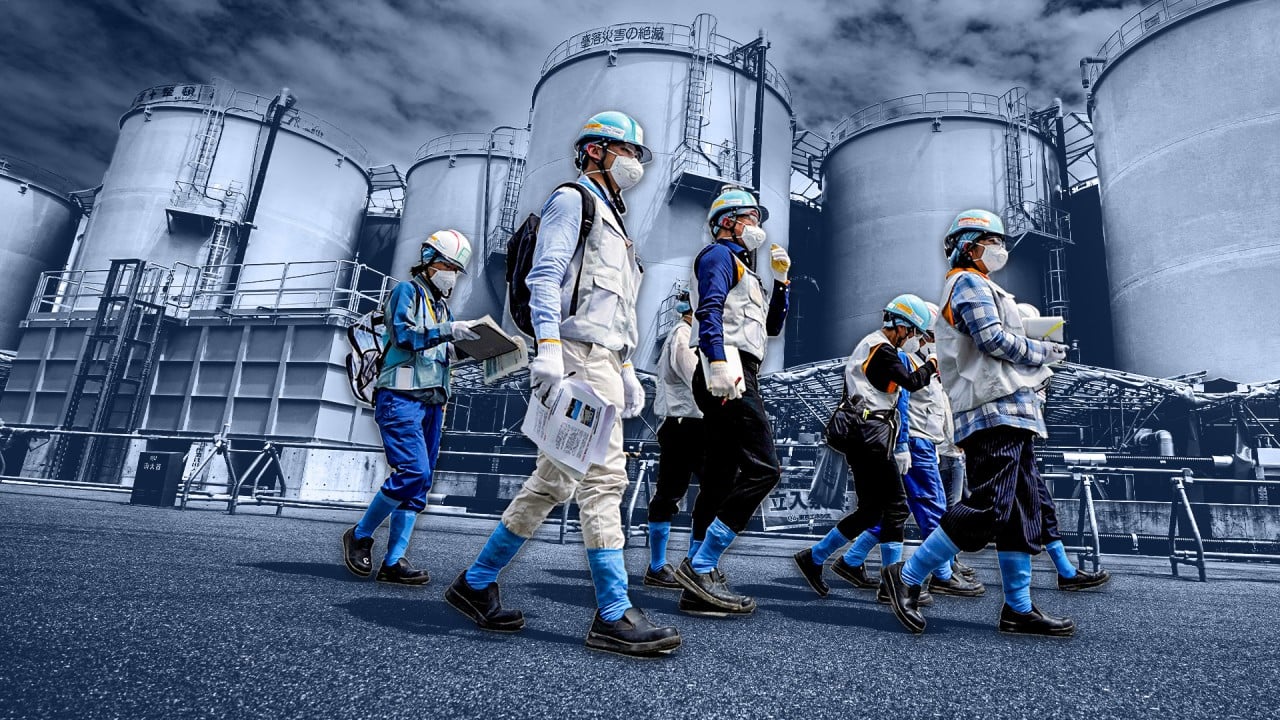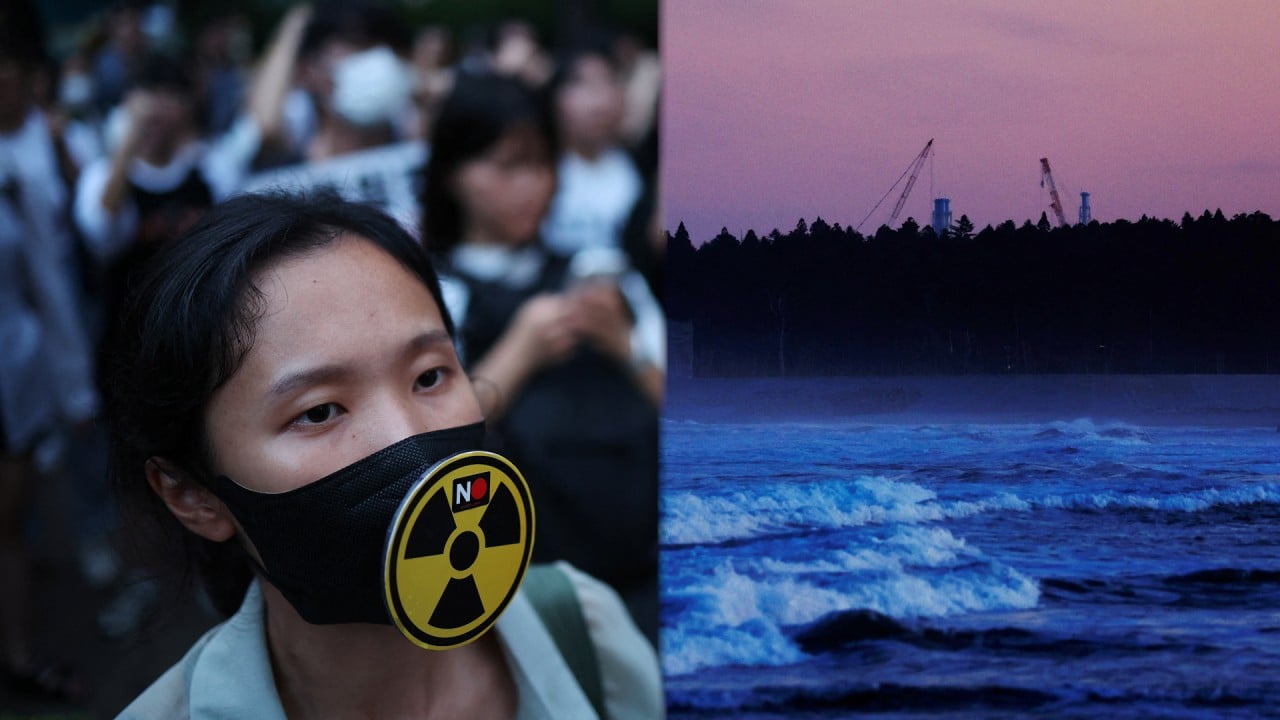
Fukushima power plant: as Japan discharges treated waste water, nuclear radiation readings don’t add up
- Discharge data logs indicate a reoccurring difference in incoming seawater and outgoing diluted waste water
- An environmental science professor says they would be expected to be about the same
The numbers were within safety limits, but they did not add up.
The seawater pumped into the plant accounts for most of the water being released. For every 20 tonnes of treated waste water discharged per hour, about 15,000 tonnes of fresh water is pumped in from the sea to dilute it.
Jim Smith, a professor of environmental science at the University of Portsmouth, said the background gamma radiation level in natural seawater was expected to be at about 10 cps.
For the seawater pumped in and diluted water discharged, “you would expect the two readings to be about the same – the gamma radiation added from gamma emitting radionuclides discharged with the waste water is unlikely to change the seawater radiation levels”, he said.
This discrepancy persisted throughout the first round of release that ended last week. The radiation level of the diluted mixture was always lower than the radiation level of the seawater being pumped in, according to Tepco data logs and their tracker on the International Atomic Energy Agency’s (IAEA) website.
Tepco’s radiation detectors monitor the seawater intake pump, the transfer line the treated water passes through, and a vertical shaft the diluted water passes through called point VI on the tracker.
“Looks to me like the detector at point VI is reading a bit low,” Smith said.
The Post sent a query about the readings observed to Tepco and the IAEA the same day. After the queries were sent, some changes were observed in the radiation data recordings.
Two days before the release began when the intake monitor began logging radiation levels, the lowest observed level was 7.9 cps.
Between August 24 and September 6, two days after the Post initially requested comment, the lowest recorded reading on the seawater intake detector was 7.0 cps.
After September 6, the seawater intake monitor started to frequently get readings in the 6 cps range.
On September 19 in their emailed response to the Post, Tepco said its monitors had “not been adjusted at all” since the time the original query was sent.
No changes were observed in the radiation detector for the diluted water.
The Post asked more than a dozen professors and researchers, some of whom had publicly spoken both for and against the release, to comment on the readings. Of the three who responded, two said that a lack of data surrounding the radiation numbers meant they would not comment.
The Post also called the IAEA regional office in Japan about the data, but were directed to the headquarters instead.
The Post was not able to connect to any of the technical experts stationed in the office that IAEA director general Rafael Grossi said was set up in Japan to specifically monitor the Fukushima water release.
Calls and emails to the IAEA headquarters and its media office went unanswered.
Smith said that while Tepco and the IAEA would be better suited to explain the readings, he suggested that the differences could be caused by monitor behaviour and data variability, or the detector at the vertical shaft reading a little low.
In response to our query about the detectors and expected radiation levels, Tepco did not acknowledge or confirm whether the radiation level of the diluted mixture should be close to the level of the incoming seawater, only that “monitor values may differ depending on differences in the surrounding environment”.
Tepco did not indicate that there was any issue with the monitor observing the diluted water, instead stating that there “may be soil deposits that could contain radioactive fallout from the accident” which could affect the values at the seawater intake monitor.
In regards to the numbers observed on September 4, Tepco said that “this is an example of a data fluctuation caused by weather/ocean conditions” which can impact the intake monitor readings due to seabed sand and disturbances from rough seas or rainfall.
But on September 8, as a typhoon passed Japan and it rained at the plant, the peak incoming seawater radiation level was 9 cps, and for most of the day the radiation level was in the range of 6 to 7 cps.
There were no notable changes to the radiation level of the diluted water on these rainy days, and Tepco did not say why none of the radioactive elements stirred up during rainfall or rough seas conditions passed into the system through the intake pumps.
“The degree of fluctuation is not significant in this case,” Tepco said.
The Post also contacted Tepco about research released in June on the storage of waste water at the plant. Tepco has cited approaching full storage capacity as a reason behind why it went ahead with the release, despite heavy opposition.
The storage capacity for the treated waste water in the tanks is around 1.37 million tonnes, and the plant is at 98 per cent capacity, according to the company’s website.
On June 9, a team of researchers with Chang Guang Satellite Technology in China released an analysis based on images obtained from Jilin 1, the world’s biggest commercial satellite system, suggesting the plant was not as close to capacity as stated.
Using images taken by the Jilin 1 satellites in February 2023, the Chang Guang scientists used artificial intelligence to calculate the plant’s tank storage capacity, based on their observation of 1,211 tanks of varying sizes. Their calculations indicated that these tanks added up to 1.78 million tonnes of storage.
Asked about the storage capacity and these calculations, Tepco restated the tank capacity was 1.37 million tonnes.
The satellite images also indicated there was uninhabitable land around the plant, including forest area, that could be used to place further storage. Based on an average tank size, the Chang Guang scientists determined that 1,001 more tanks could be placed around the plant.
Increasing the tanks by this amount could bring the potential storage capacity up to 2.75 million tonnes, their analysis said, providing storage for 53 years even with the continuously increasing water volume.
In response, Tepco said it “needs space to build new facilities required to safely continue the decommissioning process” and therefore needed to discharge the water and reduce the amount stored at the plant.
Tepco said it had examined long-term storage, including enlarging the storage capacity on site, but “the additional space for installing more tanks than currently planned is limited” both on and off site.
The forum post also said that in comparing the images from February with ones taken in December 2020, the amount of tanks and therefore storage had decreased by just over 30,000 tonnes, which it suggested was due to sealing defects in the storage tanks that caused leaks.
In a press conference on September 11, Grossi confirmed that 44 per cent of the IAEA member states had not paid their arrears, leading the IAEA to a “very serious situation”. He said that if the money was not paid, the agency “may be grinding to a halt in a month”.
Grossi confirmed that there was no global, financial situation that could explain the money being withheld, and said that he would not get into “speculations about why this may be the case”.
Bloomberg reported that draft documents showed that the US and China were the biggest debtors.
The IAEA is the only international body that has been directly monitoring the Fukushima release, and Grossi said the agency would be there “until the last drop”.





